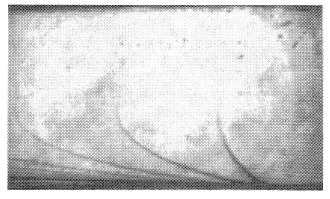A photochromic dye is a material that will undergo a reversible change in its absorption spectrum when exposed to electromagnetic radiation. A powerful method of flow visualization is provided through the use of such dyes. A nonintrusive "line marker" can be created within the liquid by exciting the dye solution with an electromagnetic radiation source, e.g., a laser. The line, or trace, will then follow the flow (fluid elements have been tagged) and its motion can be monitored (using high speed photography for instance) to reveal both qualitative and quantitative information relating to the fluid motion.
Chemically different dye types are available which will operate within different fluids, e.g., Pyridine for ethyl alcohol, Popovich and Hummel (1967), Spiropyran for aromatic solvents, Zolotorofe and Scheele (1970), or Triarylmethane for water, Fogwell and Hope (1987). The discovery of the latter dye for water flows allows studies to be conducted over a wide range of Reynolds numbers, and eliminates the safety considerations associated with the other dyes.
It is recommended that the dyestuff Acid Violet 19 (monomethyl) is used with water flows. In solution, the dye is colored magenta. The solution can be bleached using a combination of potassium sulphite and sodium metabisulphate (to keep the pH between 5 and 6) [Hope (1991)]. Irradiation with light of wavelength 308 nanometers (from a xenon-chloride excimer laser) will restore the color. The colored trace will then fade with time, the rate of which will depend on the bleach concentration, the solution temperature, the solution pH, and the overall ionic strength of the solution. The depth of trace penetration will depend on the laser power and dye concentration. Useful trace lengths of 200 millimeters have been produced. Figure 1 shows an example of dye traces within a laminar flow. The trace contrast can be enhanced optically through the use of wavelength specific interference filters.
REFERENCES
Popovich, A. T. and Hummel, R. L. (1967) A new method for non-disturbing turbulent flow measurements very close to a wall, Chem. Eng. Sci., 22. DOI: 10.1016/0009-2509(67)80100-3
Zolotorofe, D. L. and Scheele, G. F. (1970) Photochromic dye tracer measurements of small liquid velocities, Ind. Eng. Chem. Fundam., 9.
Fogwell, T. W. and Hope, C. B. (1987) Photochromic dye tracing in water flows, Experimental Heat Transfer, 1.
Hope, C. B. (1991) The Development of a Water Soluble Photochromic Dye Tracing Technique and its Application to Horizontal Two-Phase Flows, Ph.D. Thesis, Imperial College, University of London.
Referencias
- Popovich, A. T. and Hummel, R. L. (1967) A new method for non-disturbing turbulent flow measurements very close to a wall, Chem. Eng. Sci., 22. DOI: 10.1016/0009-2509(67)80100-3
- Zolotorofe, D. L. and Scheele, G. F. (1970) Photochromic dye tracer measurements of small liquid velocities, Ind. Eng. Chem. Fundam., 9.
- Fogwell, T. W. and Hope, C. B. (1987) Photochromic dye tracing in water flows, Experimental Heat Transfer, 1.
- Hope, C. B. (1991) The Development of a Water Soluble Photochromic Dye Tracing Technique and its Application to Horizontal Two-Phase Flows, Ph.D. Thesis, Imperial College, University of London.
